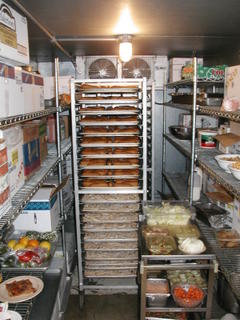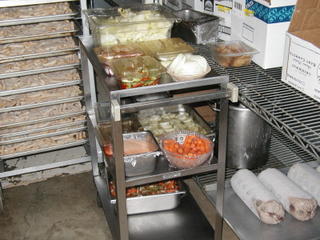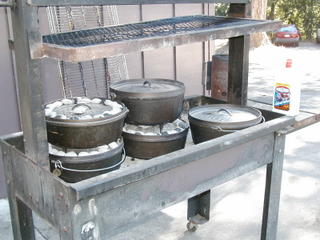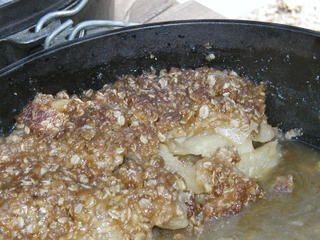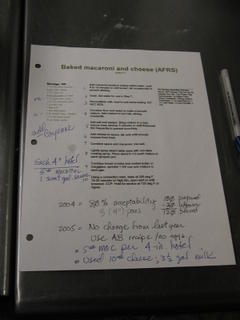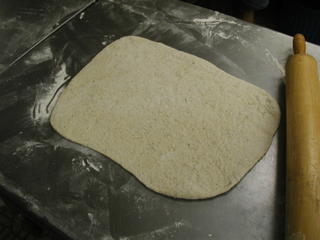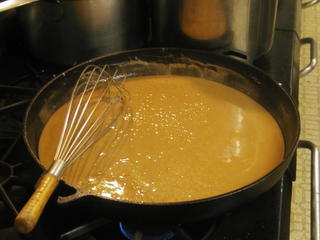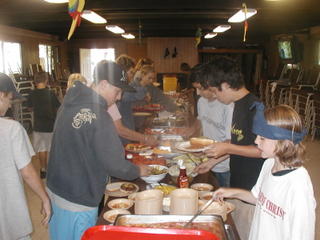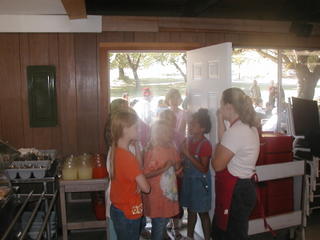Here's my recommendations for Jennifer:
Jennifer:
You go to camp the weekend that I get home. Our session this year is July 24 to 30. The advantage that I have over your trip is that I have access to a complete institutional kitchen. So many of the things I'm talking about are minor concerns for my operation.
I thought of three additional food safety concerns after I sent the email off yesterday. They are:
Potable water supply--Make sure that you have sufficient potable water being delivered to the kitchen. I can't tell you how much in terms of flow, but you need to make sure that the amount is sufficient to handle all cooking and cleaning in the kitchen. Also make sure you have a hand washing sink in the kitchen.
I would plan on using paper plates and cups for the whole week if you don't any way to adequately wash and sanitize all the dinner ware. (Remember that paperware drives waist removal.) Ideally, you should have separate sinks for vegetable prep and for washing dishes.
Sewage capacity--Of course, related to water supply is sewage. Again, I can't give you any numbers. Make sure that the existing system can handle the volume of sewage you expect to generate. This can be troublesome if you're working with a septic system. You may need to coordinate shower times with cooking times so the camp doesn't overload the sewage system.
Health permit--I can't tell you if the local jurisdiction requires a health permit or not. Some jurisdictions will, regardless of the type of group being fed. Others won't because you're a closed group who's not feeding the public.
As I said yesterday, all is not lost just because you have inadequate facilities. I've fed sailors in the field with much less than adequate kitchen facilities during my service with the Seabees. You just have to plan to bring in extra equipment and charge ahead.
Here's a few suggestions to make the week work for you:
Provide extra refrigeration--Refrigeration seems to be your biggest concern at this point. Can you secure one or more additional refrigerators? Or borrow a chest freezer for the week? Someone from your group may have one that can be transported on the back of a pick-up truck.
Worst case, you can acquire a battery of large ice coolers from the participants and use them to keep food cold. But be aware that ice coolers will normally not hold food at 41-deg or lower. My experience is that they tend to run 45- to 50-deg, even when loaded with ice. Make sure that you clean and sanitize any borrowed ice coolers before putting them to use.
We did that for a 5th-grade school trip to the coast for my daughter's class several years ago. During the organizing phase for the trip, the cook put a call out for ice coolers. We used about 12 for 80 students and adults for a three-day trip. You'll need to locate an ice source as well.
Purchase food more often--Ideally, you should try to purchase all the food for the week in one trip to the grocer. But this may not be practical for perishable food for your trip. You may need to purchase fresh and perishable food every day or every other day. If that's the case, I'd find a competent person (one who can make on-the-spot decisions) to be your shopper.
You need to be in the kitchen directing food preparation. This means that you won't have time to do the shopping during the week as well. You might be able to arrange deliveries from one of the warehouse stores (we have Costco, Smart & Final and Sam's Club in California) if you're within their delivery area.
Carefully plan the menu--If you haven't done so already, write a menu that takes limited refrigeration and cooking facilities in to consideration. This means that you'll have to purchase more ready-to-eat and more ready-to-cook products and do less scratch cooking. It also means that you may need a higher food cost dedicated to the children's meals. I run about a $5 per person per day food cost for my camp, which is higher than many summer-long camps. See my
blogs on purchasing for additional ideas.
Cook outdoors--Do you have access to cast iron Dutch ovens? If you can borrow some, it only takes four 14-inch (8-quart) ovens to feed a 6-ounce portion of a casserole to 125 campers. You need five to six 14-inch Dutch ovens to feed an 8-ounce portion.
You can still produce some wonderful meals if you combine Dutch oven cooking with the BBQ grill. You could grill a chicken hindquarter on the BBQ grill and prepare baked beans or scalloped potatoes in Dutch ovens. You can top the meal off with salads and fresh fruit instead of cooking a traditional vegetable. You can prepare a dessert in Dutch ovens or provide a ready-to-eat like cookies, fruit pie, etc.
You can also provide a two- or three-burner propane stove (the good ones are made by Camp Chef) to compliment the range in the kitchen. But remember that you shouldn't use the propane stove indoors because of fumes. And don't forget that you can place a stockpot or sauce pan on top of the BBQ grill if it's sturdy enough. This is a quick way to heat a sauce or pot of beans.
I hope that this helps you, Jennifer. I don't leave for camp until the 22nd. So I'll be available to answer questions. In fact, I'll be able to plug my laptop computer into a phone line at camp this year. I should be able to answer any last-minute questions in the week before you leave.
Steve Karoly
Concern for Inadequate Facilities at Camp, Part 1
 The center table about half-way through our unloading operation.
The center table about half-way through our unloading operation. From left to right: sausage bacon, hot dogs and bacon; lasagna; barbecued chicken; and SOS.
From left to right: sausage bacon, hot dogs and bacon; lasagna; barbecued chicken; and SOS.We saved the Cocoa Puffs and Cocoa Krispies for Saturday because they're so popular. One of the drawbacks of buying the Kelloggs and G.M. variety packs is that the campers tend to favor the sweeter breakfast cereals. They shun healthy cereals like Total, which we also saved for Saturday.

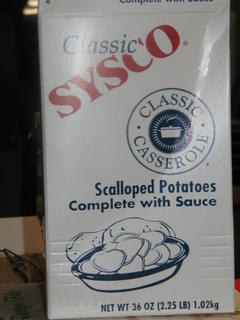
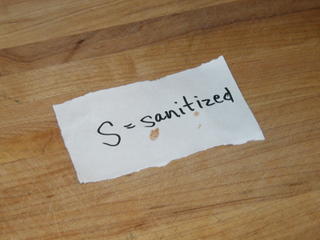 The ladies started marking sanitized surfaces with "S equals sanitized" tags this year.
The ladies started marking sanitized surfaces with "S equals sanitized" tags this year.